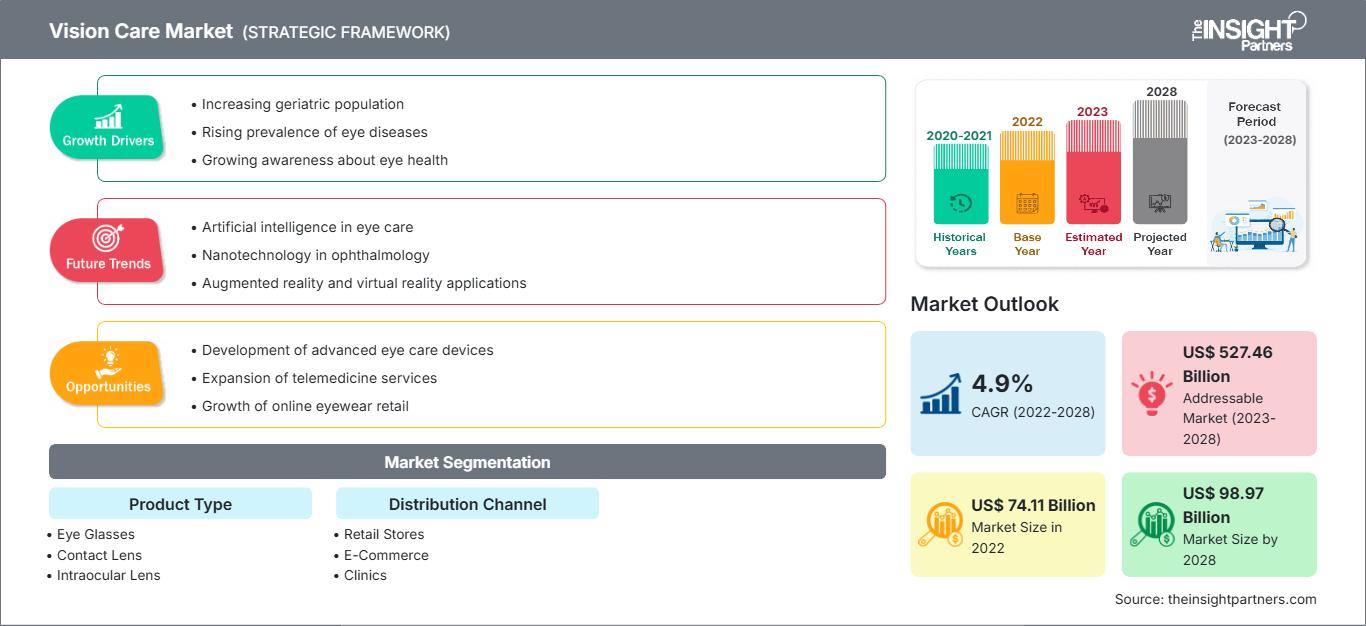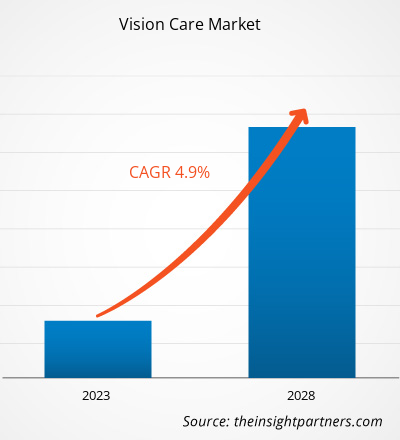Si prevede che il mercato della cura della vista crescerà da 74.110,14 milioni di dollari nel 2022 a 98.968,42 milioni di dollari entro il 2028; si stima che registrerà un CAGR del 4,9% dal 2022 al 2028.
I prodotti per la cura della vista includono occhiali, lenti a contatto, lenti intraoculari, soluzioni per lenti a contatto, colliri e altri. La crescente prevalenza di disturbi oculari stimola lo sviluppo di prodotti avanzati per la cura della vista. Inoltre, il crescente numero di programmi di sensibilizzazione sulla cura della vista stimola l'adozione di prodotti per la cura della vista in tutto il mondo.
Approfondimenti di mercato
La crescente prevalenza di malattie oculari stimola la crescita del mercato della cura della vista
Un'ampia varietà di malattie oculari, tra cui cataratta, glaucoma e difetti di rifrazione, sono diffuse in tutto il mondo. Secondo un articolo pubblicato dall'Organizzazione Mondiale della Sanità (OMS) nel 2022, circa 2,2 miliardi di persone nel mondo soffrono di problemi alla vista da vicino o da lontano. Le principali cause di problemi alla vista sono la cataratta (circa 94 milioni di casi) e gli errori di rifrazione non corretti (circa 88,4 milioni di casi). Le altre cause di problemi alla vista sono il glaucoma, le opacità corneali, la retinopatia diabetica e il tracoma, con rispettivamente circa 7,7 milioni, 4,2 milioni, 3,9 milioni e 2 milioni di casi. Secondo i dati forniti dai Centers for Disease Control and Prevention (CDC), circa 12 milioni di persone negli Stati Uniti, di età pari o superiore a 40 anni, soffrivano di problemi alla vista nel 2022, di cui 3 milioni con problemi alla vista dopo la correzione e 8 milioni con problemi alla vista dovuti a un indice di rifrazione non corretto. La crescente incidenza del diabete e di altre malattie croniche è responsabile di un'elevata prevalenza di problemi alla vista nella popolazione statunitense. Secondo i risultati del Canadian Health Measures Survey, condotto tra il 2016 e il 2019, il 50,4% degli adulti di età compresa tra 40 e 64 anni e il 71,6% degli anziani di età compresa tra 65 e 79 anni ha dichiarato di essersi rivolto a un oculista nell'ultimo anno. Inoltre, secondo il Royal National Institute of Blind People, nel 2021 nel Regno Unito circa 2 milioni di persone convivevano con una perdita della vista. Nel 2021, il numero di persone cieche o parzialmente cieche nel Regno Unito era di circa 340.000. Secondo i dati forniti dal governo indiano, nel 2021-2022 sono stati eseguiti circa 57 lakh di interventi di cataratta, mentre nel 2020-2021 ne sono stati eseguiti circa 36 lakh.
Inoltre, l'invecchiamento della popolazione e della forza lavoro in diversi paesi e le crescenti esigenze visive delle professioni moderne sottolineano l'impatto dell'ipovisione e della cecità sulle economie. Pertanto, un'elevata prevalenza di ipovisione e cecità in diverse parti del mondo stimola la crescita del mercato della cura della vista.
Personalizza questo rapporto in base alle tue esigenze
Potrai personalizzare gratuitamente qualsiasi rapporto, comprese parti di questo rapporto, o analisi a livello di paese, pacchetto dati Excel, oltre a usufruire di grandi offerte e sconti per start-up e università
Mercato della cura della vista: Approfondimenti strategici

-
Ottieni le principali tendenze chiave del mercato di questo rapporto.Questo campione GRATUITO includerà l'analisi dei dati, che vanno dalle tendenze di mercato alle stime e alle previsioni.
Una maggiore consapevolezza sulla cura della vista offre ampie opportunità per il mercato
Negli ultimi anni, sono state intraprese diverse misure e iniziative per sensibilizzare e informare le persone sulle malattie oculari, incoraggiando i pazienti ad accedere a farmaci e trattamenti adeguati per tali condizioni. Nel 2017, il National Eye Institute (NEI) negli Stati Uniti ha avviato "Write the Vision", un nuovo programma di sensibilizzazione sulla salute degli occhi, specificamente rivolto ai consumatori afroamericani. Write the Vision offre risorse mensili a numerose organizzazioni, consentendo loro di promuovere una vista sana e prevenire la perdita della vista e la cecità nelle comunità in cui operano. Secondo il National Eye Health Education Program, parte del NEI, gli afroamericani sono più inclini alle malattie oculari. Queste possono portare alla perdita della vista, se non trattate in tempo. Per questo motivo, è stato lanciato il programma "Write the Vision" per aumentare la consapevolezza sulla salute degli occhi. Sightsavers, un'organizzazione non governativa internazionale, opera nei paesi in via di sviluppo per curare e prevenire le malattie degli occhi. Gran parte della popolazione indiana vive in aree rurali, con una scarsa o nessuna consapevolezza delle patologie oculari. Sightsavers mira a sensibilizzare l'opinione pubblica con il suo programma Rural Eye Health, a fornire servizi di salute degli occhi di alta qualità e a sradicare la cecità evitabile nella popolazione rurale. Inoltre, l'OMS ha lanciato "Universal Health Coverage and Eye Care: Promoting Country Action", un evento per fornire una guida pratica, passo dopo passo, a supporto degli Stati membri dell'OMS nella pianificazione e nell'attuazione delle raccomandazioni del rapporto mondiale dell'OMS sulla vista. L'OMS ha lanciato questo evento con l'obiettivo di fornire servizi di cura degli occhi integrati e incentrati sulle persone. Pertanto, il crescente numero di tali programmi di sensibilizzazione sulla salute degli occhi sta creando opportunità di crescita per il mercato della cura della vista.
Approfondimenti basati sulla tipologia di prodotto
In base alla tipologia di prodotto, il mercato della cura della vista è segmentato in occhiali da vista, lenti a contatto, lenti intraoculari e altri. Il segmento degli occhiali da vista ha detenuto la quota di mercato maggiore nel 2021 e si prevede che crescerà al CAGR più elevato durante il periodo di previsione.
Approfondimenti basati sul canale di distribuzione
In base al canale di distribuzione, il mercato della cura della vista è segmentato in negozi al dettaglio, e-commerce, cliniche e ospedali. Il segmento dei negozi al dettaglio ha rappresentato la quota di mercato maggiore nel 2021 e si prevede che il segmento dell'e-commerce registrerà il CAGR più elevato, pari al 9,5%, durante il periodo di previsione.
Mercato della cura della vistaLe tendenze regionali e i fattori che influenzano il mercato della cura della vista durante il periodo di previsione sono stati ampiamente spiegati dagli analisti di The Insight Partners. Questa sezione illustra anche i segmenti e la geografia del mercato della cura della vista in Nord America, Europa, Asia-Pacifico, Medio Oriente e Africa, America meridionale e centrale.
Ambito del rapporto sul mercato della cura della vista
| Attributo del rapporto | Dettagli |
|---|---|
| Dimensioni del mercato in 2022 | US$ 74.11 Billion |
| Dimensioni del mercato per 2028 | US$ 98.97 Billion |
| CAGR globale (2022 - 2028) | 4.9% |
| Dati storici | 2020-2021 |
| Periodo di previsione | 2023-2028 |
| Segmenti coperti |
By Tipo di prodotto
|
| Regioni e paesi coperti |
Nord America
|
| Leader di mercato e profili aziendali chiave |
|
Densità degli operatori del mercato della cura della vista: comprendere il suo impatto sulle dinamiche aziendali
Il mercato della cura della vista è in rapida crescita, trainato dalla crescente domanda degli utenti finali, dovuta a fattori quali l'evoluzione delle preferenze dei consumatori, i progressi tecnologici e una maggiore consapevolezza dei benefici dei prodotti. Con l'aumento della domanda, le aziende stanno ampliando la propria offerta, innovando per soddisfare le esigenze dei consumatori e sfruttando le tendenze emergenti, alimentando ulteriormente la crescita del mercato.

- Ottieni il Mercato della cura della vista Panoramica dei principali attori chiave
Le aziende del mercato della cura della vista adottano strategie inorganiche e organiche, come fusioni e acquisizioni. Di seguito sono elencati alcuni recenti sviluppi chiave del mercato:
- A marzo 2022, Alcon Inc. ha lanciato la famiglia di lenti intraoculari Clareon negli Stati Uniti. Utilizzando il materiale IOL più avanzato di Alcon, Clareon può offrire risultati visivi costanti e una chiarezza eccezionale e duratura.
- A gennaio 2022, Alcon ha lanciato DAILIES TOTAL1 per astigmatismo, la prima e unica lente a contatto Water Gradient per pazienti con astigmatismo.
- A giugno 2022, CooperVision ha acquisito EnsEyes, fornitore leader di lenti a contatto per ortocheratologia (ortho-k) e sclerali nella regione nordica. L'azienda opererà all'interno del gruppo Cooper Vision Specialty EyeCare.
- A febbraio 2021, Johnson & Johnson ha acquisito Johnson Vision Inc. ha ricevuto il marchio CE per le sue lenti a contatto multifocali Acuvue Oasys con design pupillare ottimizzato per i cittadini europei. Saranno utilizzate per il trattamento di pazienti affetti da presbiopia.
Profili aziendali
- Alcon Inc
- Bausch Health Companies Inc
- Carl Zeiss AG
- Cooper Companies Inc
- Essilorluxottica SA
- Johnson And Johnson Services Inc.
- Hoya Corporation
- Rodenstock GmbH
- Menicon Co. Ltd
- Rayner Intraocular Lenses Limited
- Analisi storica (2 anni), anno base, previsione (7 anni) con CAGR
- Analisi PEST e SWOT
- Valore/volume delle dimensioni del mercato - Globale, Regionale, Nazionale
- Industria e panorama competitivo
- Set di dati Excel
Report recenti
Testimonianze
Motivo dell'acquisto
- Processo decisionale informato
- Comprensione delle dinamiche di mercato
- Analisi competitiva
- Analisi dei clienti
- Previsioni di mercato
- Mitigazione del rischio
- Pianificazione strategica
- Giustificazione degli investimenti
- Identificazione dei mercati emergenti
- Miglioramento delle strategie di marketing
- Aumento dell'efficienza operativa
- Allineamento alle tendenze normative






















 Ottieni un campione gratuito per - Mercato della cura della vista
Ottieni un campione gratuito per - Mercato della cura della vista